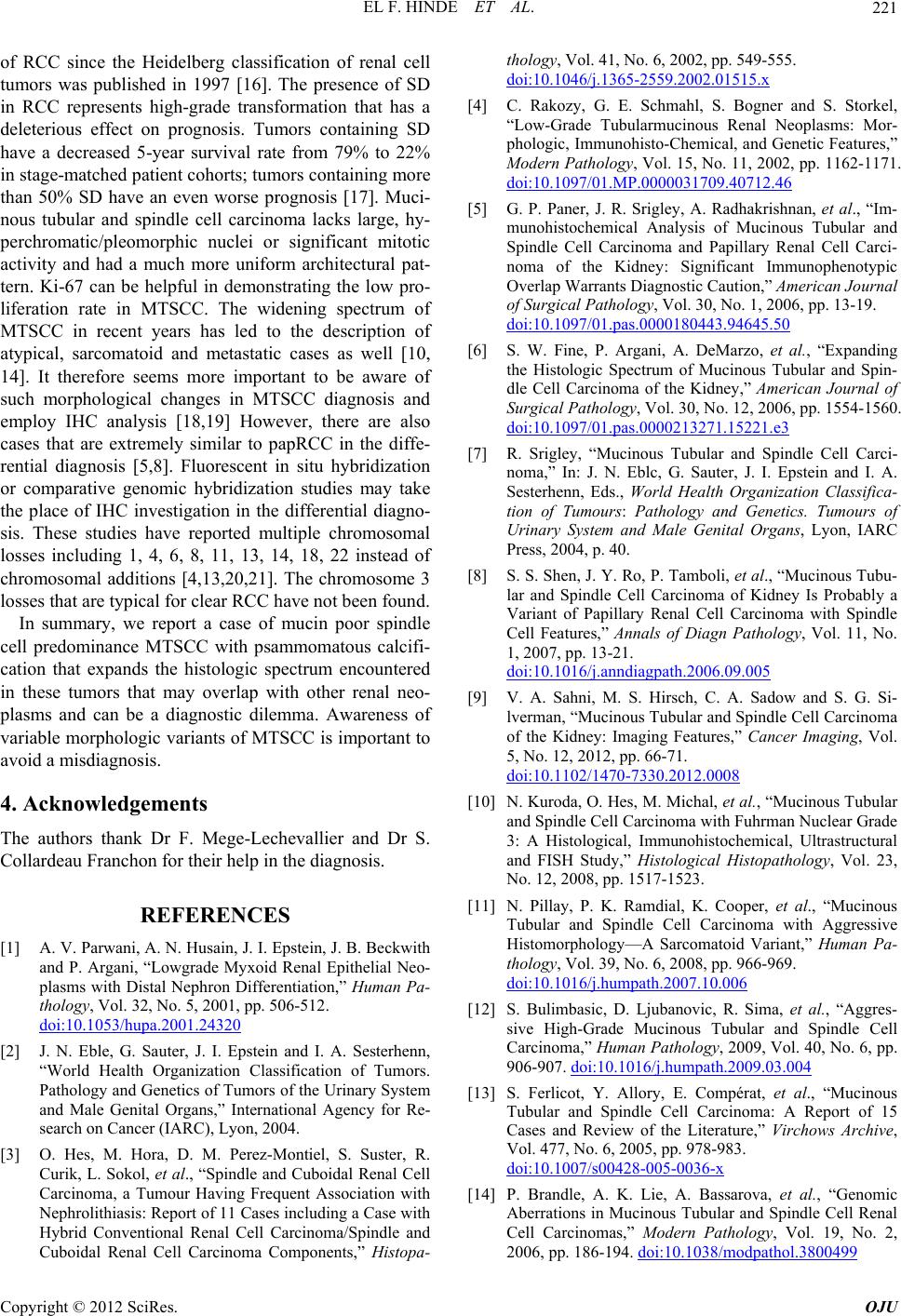
EL F. HINDE ET AL. 221
of RCC since the Heidelberg classification of renal cell
tumors was published in 1997 [16]. The presence of SD
in RCC represents high-grade transformation that has a
deleterious effect on prognosis. Tumors containing SD
have a decreased 5-year survival rate from 79% to 22%
in stage-matched patient cohorts; tumors containing more
than 50% SD have an even worse prognosis [17]. Muci-
nous tubular and spindle cell carcinoma lacks large, hy-
perchromatic/pleomorphic nuclei or significant mitotic
activity and had a much more uniform architectural pat-
tern. Ki-67 can be helpful in demonstrating the low pro-
liferation rate in MTSCC. The widening spectrum of
MTSCC in recent years has led to the description of
atypical, sarcomatoid and metastatic cases as well [10,
14]. It therefore seems more important to be aware of
such morphological changes in MTSCC diagnosis and
employ IHC analysis [18,19] However, there are also
cases that are extremely similar to papRCC in the diffe-
rential diagnosis [5,8]. Fluorescent in situ hybridization
or comparative genomic hybridization studies may take
the place of IHC investigation in the differential diagno-
sis. These studies have reported multiple chromosomal
losses including 1, 4, 6, 8, 11, 13, 14, 18, 22 instead of
chromosomal additions [4,13,20,21]. The chromosome 3
losses that are typical for clear RCC have not been found.
In summary, we report a case of mucin poor spindle
cell predominance MTSCC with psammomatous calcifi-
cation that expands the histologic spectrum encountered
in these tumors that may overlap with other renal neo-
plasms and can be a diagnostic dilemma. Awareness of
variable morphologic variants of MTSCC is important to
avoid a misdiagnosis.
4. Acknowledgements
The authors thank Dr F. Mege-Lechevallier and Dr S.
Collardeau Franchon for their help in the diagnosis.
REFERENCES
[1] A. V. Parwani, A. N. Husain, J. I. Epstein, J. B. Beckwith
and P. Argani, “Lowgrade Myxoid Renal Epithelial Neo-
plasms with Distal Nephron Differentiation,” Human Pa-
thology, Vol. 32, No. 5, 2001, pp. 506-512.
doi:10.1053/hupa.2001.24320
[2] J. N. Eble, G. Sauter, J. I. Epstein and I. A. Sesterhenn,
“World Health Organization Classification of Tumors.
Pathology and Genetics of Tumors of the Urinary System
and Male Genital Organs,” International Agency for Re-
search on Cancer (IARC), Lyon, 2004.
[3] O. Hes, M. Hora, D. M. Perez-Montiel, S. Suster, R.
Curik, L. Sokol, et al., “Spindle and Cuboidal Renal Cell
Carcinoma, a Tumour Having Frequent Association with
Nephrolithiasis: Report of 11 Cases including a Case with
Hybrid Conventional Renal Cell Carcinoma/Spindle and
Cuboidal Renal Cell Carcinoma Components,” Histopa-
thology, Vol. 41, No. 6, 2002, pp. 549-555.
doi:10.1046/j.1365-2559.2002.01515.x
[4] C. Rakozy, G. E. Schmahl, S. Bogner and S. Storkel,
“Low-Grade Tubularmucinous Renal Neoplasms: Mor-
phologic, Immunohisto-Chemical, and Genetic Features,”
Modern Pathology, Vol. 15, No. 11, 2002, pp. 1162-1171.
doi:10.1097/01.MP.0000031709.40712.46
[5] G. P. Paner, J. R. Srigley, A. Radhakrishnan, et al., “Im-
munohistochemical Analysis of Mucinous Tubular and
Spindle Cell Carcinoma and Papillary Renal Cell Carci-
noma of the Kidney: Significant Immunophenotypic
Overlap Warrants Diagnostic Caution,” American Journal
of Surgical Pathology, Vol. 30, No. 1, 2006, pp. 13-19.
doi:10.1097/01.pas.0000180443.94645.50
[6] S. W. Fine, P. Argani, A. DeMarzo, et al., “Expanding
the Histologic Spectrum of Mucinous Tubular and Spin-
dle Cell Carcinoma of the Kidney,” American Journal of
Surgical Pathology, Vol. 30, No. 12, 2006, pp. 1554-1560.
doi:10.1097/01.pas.0000213271.15221.e3
[7] R. Srigley, “Mucinous Tubular and Spindle Cell Carci-
noma,” In: J. N. Eblc, G. Sauter, J. I. Epstein and I. A.
Sesterhenn, Eds., World Health Organization Classifica-
tion of Tumours: Pathology and Genetics. Tumours of
Urinary System and Male Genital Organs, Lyon, IARC
Press, 2004, p. 40.
[8] S. S. Shen, J. Y. Ro, P. Tamboli, et al., “Mucinous Tubu-
lar and Spindle Cell Carcinoma of Kidney Is Probably a
Variant of Papillary Renal Cell Carcinoma with Spindle
Cell Features,” Annals of Diagn Pathology, Vol. 11, No.
1, 2007, pp. 13-21.
doi:10.1016/j.anndiagpath.2006.09.005
[9] V. A. Sahni, M. S. Hirsch, C. A. Sadow and S. G. Si-
lverman, “Mucinous Tubular and Spindle Cell Carcinoma
of the Kidney: Imaging Features,” Cancer Imaging, Vol.
5, No. 12, 2012, pp. 66-71.
doi:10.1102/1470-7330.2012.0008
[10] N. Kuroda, O. Hes, M. Michal, et al., “Mucinous Tubular
and Spindle Cell Carcinoma with Fuhrman Nuclear Grade
3: A Histological, Immunohistochemical, Ultrastructural
and FISH Study,” Histological Histopathology, Vol. 23,
No. 12, 2008, pp. 1517-1523.
[11] N. Pillay, P. K. Ramdial, K. Cooper, et al., “Mucinous
Tubular and Spindle Cell Carcinoma with Aggressive
Histomorphology—A Sarcomatoid Variant,” Human Pa-
thology, Vol. 39, No. 6, 2008, pp. 966-969.
doi:10.1016/j.humpath.2007.10.006
[12] S. Bulimbasic, D. Ljubanovic, R. Sima, et al., “Aggres-
sive High-Grade Mucinous Tubular and Spindle Cell
Carcinoma,” Human Pathology, 2009, Vol. 40, No. 6, pp.
906-907. doi:10.1016/j.humpath.2009.03.004
[13] S. Ferlicot, Y. Allory, E. Compérat, et al., “Mucinous
Tubular and Spindle Cell Carcinoma: A Report of 15
Cases and Review of the Literature,” Virchows Archive,
Vol. 477, No. 6, 2005, pp. 978-983.
doi:10.1007/s00428-005-0036-x
[14] P. Brandle, A. K. Lie, A. Bassarova, et al., “Genomic
Aberrations in Mucinous Tubular and Spindle Cell Renal
Cell Carcinomas,” Modern Pathology, Vol. 19, No. 2,
2006, pp. 186-194. doi:10.1038/modpathol.3800499
Copyright © 2012 SciRes. OJU